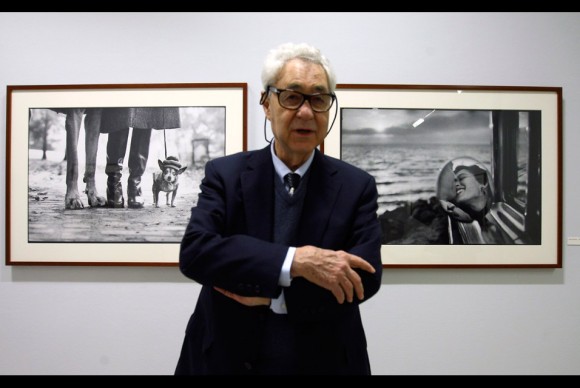Christiane Amanpour Talks with Photographers Elliott Erwitt and Roberto Salas
NEW YORK (CUBAN ART NEWS).- “Che did not like having his picture taken too much. About that, I have a personal theory.”
Roberto Salas was on stage at The Times Center in midtown Manhattan, holding court with fellow photographer Elliott Erwitt as they recalled their experiences covering the early years of Castro’s government. Presented earlier this month in conjunction with the International Center of Photography’s exhibition Cuba in Revolution, the evening was moderated by media journalist Christiane Amanpour. Amid a celebrity-dotted crowd that included actress Uma Thurman and writer Fran Liebowitz, the program opened with a tete-a-tete with international financier Arpad Busson, from whose photography collection Cuba in Revolution was drawn, and closed with a spirited panel discussion about “the complexities of Cuba today.” But for photography aficionados, the conversation with Salas and Erwitt was the high point of the evening.
The son of photojournalist Osvaldo Salas, Roberto Salas was born and raised in New York City. He left at age 18 to photograph the revolution, on the first flight to leave New York for Havana after the rebels took the capital. “I arrived in a plane that was full of rifles and pistols and things like that, that were lying around New York, waiting for the right moment,” he recalled with a laugh. “A few days before, I’m riding on buses and subways in New York. A couple days later, I’m surrounded by long hair and beards and rifles. I was in a fantasy world.” Salas has lived in Cuba ever since.
As a teenager, “I worked with my father, doing weddings and birthday parties. In New York,” he said, “I took pictures. When I got to Cuba, I started to learn how to do photography.” Though U.S.-born, Salas included himself among the Cuban photographers who were documenting the government in those early days. “For all of us, it was a learning process,” he said. “None of the Cuban group, except my father, had done any press work.” Osvaldo Salas made several trips to Cuba with Roberto in 1959 and 1960, but maintained a photo studio and business in New York.
Unlike Salas, who chronicled the new government from the beginning, Elliott Erwitt—a much-honored Magnum photojournalist and art photographer—spent approximately a week with Castro and Che Guevara in 1964, on assignment from Newsweek. “My trip was not very profound,” he said, but he noted that for that brief time, he had uncommon access to Castro and his circle. “Fidel seemed to me like kind of a cowboy,” he said. At one point he and Castro went to a baseball game, “as spectators. And he decided that he would like to pitch a game, so he went into the field and he started playing baseball. And when he went up to bat, he got very, very easy throws.” Amid audience laughter, Erwitt added, “I got the impression that whatever he wanted to do, he could do. And he did. He kissed babies, he visited places. Sort of like running for office.”
Erwitt found Guevara to be “slightly sour,” although “he gave me a box of cigars, and that was very nice.” Salas’s experience of Che was not entirely different from Erwitt’s. “But sometime later I found out that when he was sour to people, it was because he liked them,” Salas said. “If he didn’t like you, he didn’t even talk to you.” As to why Guevara disliked being photographed, Salas explained that “Che always had a camera with him. He loved photography. And he did some things, photography from the art point of view. My theory is, he didn’t like to have his picture taken because he was a photographer. I haven’t met anybody in our profession who likes to have their own picture taken.”
Queried by Amanpour about the heroic iconography of Castro, Guevara, and other Cuban leaders that dominates the exhibition, Erwitt commented that “It would be very difficult to take a non-heroic picture of them. It’s the nature of their presence—their theatrical presence. They’re theatrical people. Of course,” he conceded wryly, “there are other qualities to them. They did make the revolution.” Having spent time in Cuba under the Batista regime, “I certainly was in favor of a change,” Erwitt said. “Maybe not that radical a change, but certainly a change. It was interesting to see it before and after, although I was seeing it after through the eyes of these principal players.”
“And did you find a satisfied population?” Amanpour asked. “One with a different relationship to their leaders?”
“Yes. Absolutely,” Erwitt responded. “They were like rock stars. Absolutely.”
“So what will history say about Fidel Castro?” Amanpour pressed. “That he was a rock star? Or that he—what did he do for Cuba?”
“I don’t know that they’ll say that he was a rock star,” Erwitt replied. “I think the pictures will say that. But I think the substance might be something else. Substance,” he added, “is not necessarily pictures.”
Cuba in Revolution remains on view at the International Center of Photography in New York through January 9.
Related posts:
- International Center of Photography Celebrates Elliott Erwitt’s Career with Exhibition
- Platinum Prints & Classic Snaps by Elliott Erwitt at Magnum Print Room
- Cuba in Revolution at the International Center of Photography
- Center for Cuban Studies Art Space Shows Rare Photographs
- MoMa shows classic photos by female photographers

